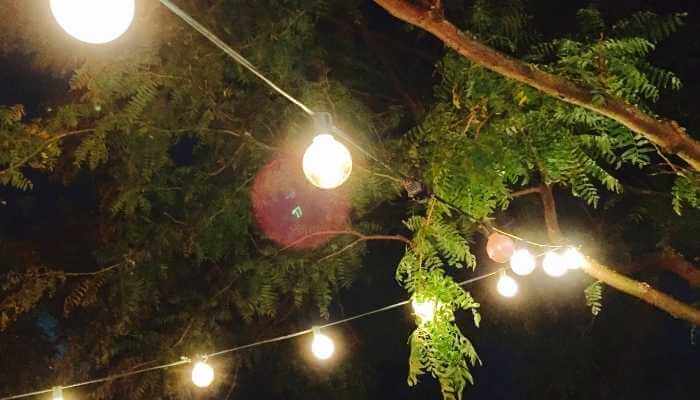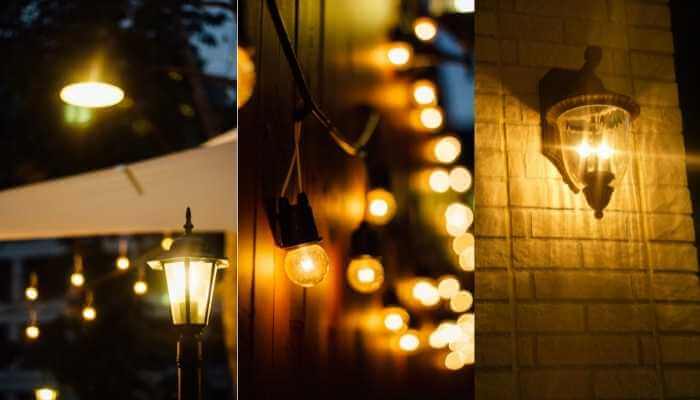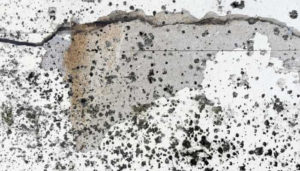Hmmm, now this is a good question. Sometimes you just don’t want to use unsightly nails in your wood. Besides, the wood right around those nails is going to degrade much quicker. So, if you want to still hang string lights or fairy lights on your covered patio, you’ve got to be creative.
There are several innovative methods for hanging your string lights up on your covered patio without using nails. This includes using trees and posts or what’s already available. But your potential tools are adhesive hooks, tape, gutter hooks, brick or siding clips, and even staples.
Want to hear about some of the ideas that I’ve put into use and some ideas I’ve collected from other people and designers? Then keep reading!
Hanging Lights on Trees or Posts
In one of our previous backyards, we had plenty of trees around the outdoor gathering space. Therefore, we found sturdy enough lower limbs and we wrapped out guidelines around those and set them up between the trees so we could then run the string lights between them. No nails were used.
If you don’t have that lucky set of circumstances, you can still manage. You can use posts around your patio for attaching guidewires. Then, you can string those lights between the guidewires. You just need to be sure to get posts tall enough to allow for the burial of at least a foot and a half into the ground and cement to steady them there.
And you can use posts that are portable, too! Affix a post into a bucket and fill the thing all around the post with Quickrete. Then, you can move that post all over the place and it’s going to be pretty sturdy and not blow away. You can string lights from these posts any way you want and not harm your permanent structures with nails.
Using What’s Already There
In our case, we have huge 6×6 pieces that make up the pergola. There are what look to be door handles already drilled into the inside of those where a shade covering is tied down. I’m planning to use these parts. I will be connecting some chain links or gutter hooks (whichever works best) and then adding the lights through the chain. Because the lights are LED, they won’t harm the cover that’s also connected there.
Using Adhesive Hooks
Now, when it comes to Command Wire hooks, I’ve had some good experiences and some bad experiences. I can tell you that the slicker the base you’re putting this adhesive on, the less likely it will hold over time. I don’t want you to be like me and have something expensive fall because you tried this method, so be absolutely sure it’s going to hold.
A suggestion I have for this – if you don’t mind the glue being there – is to reinforce the adhesive with Gorilla Glue or something stronger. If you have hooks set up on each side of your upper portion of the patio cover, you can then string those lights from one side to the other easily enough.
If you’re lucky enough to use just the adhesive, this can be a boon, because if you ever need to remove the lights or the hooks, the adhesive can theoretically be removed and leave the wall or surface beneath with no issues. In my experience, it still leaves adhesive traces, and if you use it on wallpaper, the wallpaper will be torn if you try and remove the hooks.
To remove the adhesive beneath these hooks from a wall, you may want to use a hairdryer to get the adhesive to be more malleable, and then you can use a scraper or even dental floss at the right angle to remove it.
Using Adhesive Tape
Tape is an iffy situation. Obviously, if you have a place that you can tape around an item so that the tape goes back onto itself, this is optimal. Tape sticks to itself very well and then it’s not leaving adhesive everywhere. However, in most cases of hanging string lighting, you’re literally taping the light string to the inside of the patio structure.
Using clear boxing or mailing tape is best because it’s strong and it’s clear so it won’t be as noticeable. If you find that the lights you’re using are heavy enough to force you to use duct tape, just remember that it’s available in different colors (including wood grain and almost black woodgrain finish) now, so that can help with aesthetics.
There is also an outdoor mounting tape available for use on brick and wood alike. It stands up better to the elements and the adhesive is obviously stronger. Removing it can be difficult, and you may have to use rubbing alcohol to get that stuff off.
No matter which adhesive tape you use, there will always be an adhesive left behind when you remove it. For removing tape residue, hairdryers and scrapers can also be used. If that doesn’t seem to be working and your surface can take it, a soap and water mixture might be the way to go.
Hanging Lights with Gutter hooks
Again, depending upon the cover and roofing of your outdoor living space and patio area, you may be able to get away with simply using gutter hooks to accomplish your light stringing needs.
Gutter hooks come in all shapes and sizes, you may want to look them up as Christmas Light Hooks online. Usually, they have an “S” shape or they have a roof gripping side and a loop on the other side for the lighting. You hang one side from the gutter or the roofing of your house (or the roof over your patio).
Then, you can use the guidewire method and hang the guide wires from these. Once you have guidewires, you can weave the string lights back and forth over the patio. Otherwise, you can string the lights up directly to these little tools and they will just be around the space, not over it.
If you are using your house’s gutters the gutter hooks, and your string lights are then strung across the space to your pergola or other structure, you just have to find a way of attaching them to the other structure. If it’s a pergola, that becomes as easy as wrapping them around the top beam and then going back and forth to the gutter and then back to the beam.
Brick Clips or Siding Clips
Yes, these are things! These clips, both kinds, are designed to sturdily hold on to their appointed material without causing damage or leaving adhesive residue behind when you take them down.
Brick clips fit over the face of the brick. As long as the brick and mortar aren’t completely flush, if you have a decorative hang on your brick wall at the right height, these clips can be used. You simply place the top of the clip on the top of the brick and press down until the springs on the bottom snap over the edge into place. And Voila!
Vinyl siding hooks have the same premise, but you’re hooking them under the lip of the vinyl siding that’s on your house or shed. They hold a lot of weight and you don’t have to make a hole in your house to hang these things.
Like when you use gutter hooks, your string lights are hooked here and then strung across the space to your pergola or other structure. You just have to find a way of attaching them to the other structure. If it’s a pergola, that becomes as easy as wrapping them around the top beam and then going back and forth to the clips and then back to the beam.
Hanging Lights with Staples
I saved this option for last because, honestly, it’s almost as bad as using nails to hand your string lights. On the plus side, they’re stronger than tape and adhesive hooks for the most part. Conversely, staples will rust and will leave a mess where they are attached. Plus, once you staple something, it’s there. You have to be sure the material you’re attaching your lights to will handle the staple in the first place – usually, this is for wood.
You also need to be sure and have an extra space-saver like a small piece of metal or wood (I use a metal skewer from the kitchen) to place on the top of the string light cord when you staple. Otherwise, the staple might go into the cord covering and you’ll end up with an electrical hazard. Or get a stapler that has a power adjustment to keep the staples at the proper depth.
In conclusion…
Each backyard space is different. Therefore, you may have a different type of material that’s surrounding your outdoor living space than the next person. This is going to affect what you can and cannot use to hold up string lights. The weight of your lights is also a major factor here. I mean, there’s a huge difference in the weight of fairy lights contrasted to the weight of a strand of Edison-bulb filament lights.
If we’re talking about a patio that has a cover, your hanging technique will rely on the type of cover and its strength of it, and its bracing or understructure. This article took a look at several suggestions for hanging string lights without the need for nails, how these will work with various support structures, and in some cases, even how to clean up should you need to remove the lights. I hope it was useful to you!













